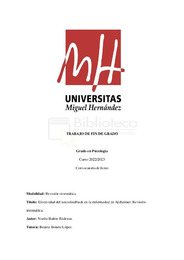Por favor, use este identificador para citar o enlazar este ítem:
https://hdl.handle.net/11000/30170Registro completo de metadatos
| Campo DC | Valor | Lengua/Idioma |
|---|---|---|
| dc.contributor.advisor | Bonete López, Beatriz | - |
| dc.contributor.author | Bañón Ródenas, Noelia | - |
| dc.contributor.other | Departamentos de la UMH::Psicología de la Salud | es_ES |
| dc.date.accessioned | 2023-11-15T13:42:13Z | - |
| dc.date.available | 2023-11-15T13:42:13Z | - |
| dc.date.created | 2023-06 | - |
| dc.identifier.uri | https://hdl.handle.net/11000/30170 | - |
| dc.description.abstract | La enfermedad de Alzheimer es el tipo de demencia más común en la actualidad. Cantidad de personas se encuentran afectadas por esta enfermedad, y por ello, cada vez estará más presente. Debido a la progresiva muerte neuronal que se produce en el tejido cerebral de los pacientes que la sufren, se genera deterioro cognitivo en todas las áreas, principalmente en la memoria, lo que conlleva un gran impacto en la calidad de vida. En la actualidad, ni los tratamientos farmacológicos ni los no farmacológicos, han podido detener la muerte neuronal que se produce, aunque están destinados a paliar los efectos del deterioro cognitivo global, así como mejorar sus síntomas fisiológicos y psicológicos. La cuestión de este trabajo se centra en el Neurofeedback, uno de los métodos de intervención mediante estimulación cognitiva, basado en el concepto de neuroplasticidad y reserva cognitiva. El refuerzo que se produce en las conexiones neuronales muestra grandes resultados, dotando a la técnica de una gran relevancia en la actualidad. Por lo tanto, el objetivo fundamental del trabajo que se presenta, es una revisión de la literatura científica sobre la evidencia actual del Neurofeedback en pacientes con enfermedad de Alzheimer. Para la búsqueda bibliográfica, se han recopilado un total de 9 artículos, utilizando las bases de datos de PubMed y Scopus. Los resultados sugieren que el Neurofeedback muestra beneficios en la cognición, la calidad de vida y un incremento de emociones positivas en los pacientes. | es_ES |
| dc.description.abstract | Alzheimer's disease is the most common type of dementia today. A large number of people are affected by this disease, and as a result, it is becoming increasingly prevalent. Due to the progressive neuronal death that occurs in the brain tissue of patients suffering from the disease, cognitive deterioration is generated in all areas, mainly in memory, which has a great impact on quality of life. At present, neither pharmacological and non-pharmacological treatments have been able to stop the neuronal death that occurs, although they are aimed at alleviating the effects of global cognitive deterioration, as well as improving its physiological and psychological symptoms. The focus of this paper is on Neurofeedback, one of themethods of intervention through cognitive stimulation, based on the concept of neuroplasticity and cognitive reserve. The reinforcement that occurs in the neuronal connections shows great results, giving the technique a great relevance nowadays. Therefore, the main objective of the work presented here is a review of the scientific literature on the current evidence of Neurofeedback in patients with Alzheimer's disease. For the literature search, a total of 9 articles have been compiled, using the PubMed and Scopus databases. The results suggest that Neurofeedback shows benefits in cognition, quality of life and an increase in positive emotions in patients. | es_ES |
| dc.format | application/pdf | es_ES |
| dc.format.extent | 36 | es_ES |
| dc.language.iso | spa | es_ES |
| dc.publisher | Universidad Miguel Hernández de Elche | es_ES |
| dc.rights | info:eu-repo/semantics/openAccess | es_ES |
| dc.rights.uri | http://creativecommons.org/licenses/by-nc-nd/4.0/ | * |
| dc.subject | Alzheimer | es_ES |
| dc.subject | Demencia | es_ES |
| dc.subject | Neurofeedback | es_ES |
| dc.subject.other | CDU::1 - Filosofía y psicología::159.9 - Psicología | es_ES |
| dc.title | Efectividad del neurofeedback en la enfermedad de Alzheimer: Revisión sistemática | es_ES |
| dc.type | info:eu-repo/semantics/bachelorThesis | es_ES |

Ver/Abrir:
BAÑON RODENAS NOELIA TFG.pdf
650,17 kB
Adobe PDF
Compartir:
 La licencia se describe como: Atribución-NonComercial-NoDerivada 4.0 Internacional.
La licencia se describe como: Atribución-NonComercial-NoDerivada 4.0 Internacional.
Herramientas de Administrador
.png)